The 2022 Honda PCX 160 Review
-
Recently Browsing 0 members
- No registered users viewing this page.
-
Topics
-
-
Popular Contributors
-
-
Latest posts...
-
37
THAILAND LIVE Thailand Live Saturday 9 August 2025
Police Raid Villa in Jomtien, Arrest 26 Chinese Nationals Picture courtesy of ที่นี่ พัทยา Chonburi Provincial Police Commander, Police Major General Thawatchi Jindakwarnsanong, has ordered a crackdown on illegal activities at a pool villa in the Jomtien Beach area. Full story:https://aseannow.com/topic/1369283-police-raid-villa-in-jomtien-arrest-26-chinese-nationals/ -
32
USA Judge Halts 'Alligator Alcatraz' Over Everglades Threat
They're getting all the due diligence they're entitled to. You may not be happy with the level, but it's been that way for decades. I've been pulled over dozens of times within 100 miles of the Texas border, starting in the '80s when I worked the oilfields of S Texas. It never seemed kosher, but them's the rules. Long before Trump. -
14
Retired expat out there who has been issued with a TIN number?
About 3 years ago tax office issued me a TIN for tax from bank fixed accounts. I don't even bother to apply anymore since last year. -
14
Retired expat out there who has been issued with a TIN number?
In Sattahip they told me it was not needed, but they would give me a tin no. if I insisted, but then I would have to fill in an annual tax return. Decided not to bother I have enough problems with HMRC as it is. -
1,578
What Movies or TV shows are you watching (2025)
Weapons Could be one to look out for: https://collider.com/weapons-review-zach-cregger-josh-brolin-julia-garner/ -
10
Crime Pattaya Beach Woman & Ladyboy Rob Australian Man
If it has a dick it is not a woman!- 1
-

-
-
Popular in The Pub








Recommended Posts
Create an account or sign in to comment
You need to be a member in order to leave a comment
Create an account
Sign up for a new account in our community. It's easy!
Register a new accountSign in
Already have an account? Sign in here.
Sign In Now